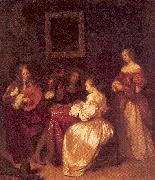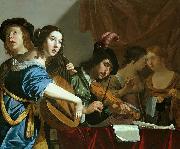Wholesale Oil Painting No Minimum |
|||||||||||
|
|
|||||||||||

|
|||||||||||
|
|
|
||||||||
NETSCHER, CasparDutch Baroque Era Painter, ca.1635-1684 |
||||||||
|
|
||||||||
Musical Company
Musical Company Painting ID:: 19639 |
1665
Oil on canvas
Alte Pinakothek, Munich. 1665 Oil on canvas Alte Pinakothek, Munich. |
|||||||
|
|
||||||||
Jan van BijlertDutch Baroque Era Painter, ca.1597-1671 Dutch painter. He was the son of the Utrecht glass painter Herman Beerntsz. van Bijlert (c. 1566-before 1615). Jan must have trained first with his father but was later apprenticed to the painter Abraham Bloemaert. After his initial training, he visited France and travelled to Italy, as did other artists from Utrecht. Jan stayed mainly in Rome, where he became a member of the Schildersbent; he returned to Utrecht in 1624. In Rome he and the other Utrecht artists had come under the influence of the work of Caravaggio; after their return home, this group of painters, who became known as the UTRECHT CARAVAGGISTI, adapted the style of Caravaggio to their own local idiom. The Caravaggesque style, evident in van Bijlert's early paintings, such as St Sebastian Tended by Irene (1624; Rohrau, Schloss; see fig.) and The Matchmaker (1626; Brunswick, Herzog Anton Ulrich-Mus.), is characterized by the use of strong chiaroscuro, the cutting off of the picture plane so that the image is seen close-up and by an attempt to achieve a realistic rather than idealized representation. |
||||||||
|
|
||||||||
|
|
Musical Company
Musical Company Painting ID:: 52606 |
Oil on panel, 97 x 115 cm Oil on panel, 97 x 115 cm |
||||||
|
|
||||||||
|
Jan van Bijlert Dutch Baroque Era Painter, ca.1597-1671 Dutch painter. He was the son of the Utrecht glass painter Herman Beerntsz. van Bijlert (c. 1566-before 1615). Jan must have trained first with his father but was later apprenticed to the painter Abraham Bloemaert. After his initial training, he visited France and travelled to Italy, as did other artists from Utrecht. Jan stayed mainly in Rome, where he became a member of the Schildersbent; he returned to Utrecht in 1624. In Rome he and the other Utrecht artists had come under the influence of the work of Caravaggio; after their return home, this group of painters, who became known as the UTRECHT CARAVAGGISTI, adapted the style of Caravaggio to their own local idiom. The Caravaggesque style, evident in van Bijlert's early paintings, such as St Sebastian Tended by Irene (1624; Rohrau, Schloss; see fig.) and The Matchmaker (1626; Brunswick, Herzog Anton Ulrich-Mus.), is characterized by the use of strong chiaroscuro, the cutting off of the picture plane so that the image is seen close-up and by an attempt to achieve a realistic rather than idealized representation. Musical Company Oil on panel, 97 x 115 cm |
||||||||
|
|
||||||||
|
Prev Next
|
||||||||
|
|
||||||||
|
Related Paintings to Jan van Bijlert :. |
||||||||
|
|
||||||||
|
CONTACT US |


